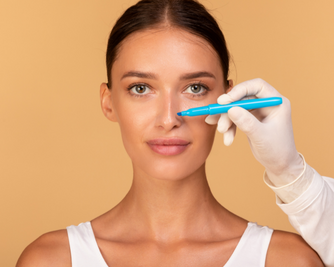It seems everyone’s so excited about getting a nose job that no one talks about revision rhinoplasty anymore. Revisions don’t always mean mistakes or unsavory changes to the nose’s size, shape, and design. Sometimes, multiple surgeries are necessary for patients to get their desired outcome, as the name revision rhinoplasty implies.
Dr. Matt Hershcovitch, MD, a double-board facial plastic surgeon in the greater Los Angeles area, wants everyone considering a nose job to understand that revisions are sometimes part of the journey. Below are eight of the most common questions his patients have about revision rhinoplasty.
1. What is revision rhinoplasty?
A revision nose job is a type of surgery that changes the structure and features of the nose to improve its appearance and, in some cases, function. The procedure is only performed on people who’ve had rhinoplasties in the past (more than 12 months ago) and who are unhappy with their noses. Revision rhinoplasty corrects undesirable changes commonly due to aging, poor post-operative care adherence, and personal preferences.
2. Why should I choose you as my revision rhinoplasty surgeon?
It’s strictly to your benefit to choose Dr. Matt Hershcovitch, MD, to perform your revision nose job surgery. It takes exceptional skill and expertise to perform revision rhinoplasty successfully. Dr. H. is a widely successful, popular, and down-to-earth double-board certified plastic surgeon specializing in all kinds of rhinoplasty procedures.
Many reviews and testimonials are available online, on our website, and in the office during the consultation for potential patients like you. There’s also a great gallery of before and after photos to review.
3. Do I need a revision rhinoplasty?
Revision surgery is for patients who require additional surgical alterations to achieve the desired outcome or correct issues that may arise during recovery or years later due to injury, aging, or preference. These issues may be apparent after previous operations or develop some time later. Either way, patients can have revisions made to their noses to correct them.
4. What are the risks?
Nose job revisions come with a heightened risk of complications, in most cases, can be minimized by choosing a qualified surgeon with extensive knowledge and surgical skill. Any surgeon you choose for revision rhinoplasty should be forthcoming about the risks involved. Patients aware of their unique risks are better equipped to make informed decisions.
Revision rhinoplasty risks include bleeding, adverse medication reactions, nasal blockage, excess scar tissue, infection, temporary loss of sense of smell, and healing impairments. Although rare, patient dissatisfaction due to unrealistic expectations and additional cosmetic nose or functional issues can also occur.
Before scheduling patients, Dr. Hershcovitch, MD, discusses all risks and addresses patient concerns to increase awareness of revision rhinoplasty risks and to dispel all unrealistic expectations. It’s important for patients to know what to expect before having the procedure.
5. How long does revision rhinoplasty take?
Revision rhinoplasty takes several hours to perform. The exact timeframe for your procedure may be longer or shorter, depending on the amount of work necessary to achieve the desired effects, the rhinoplasty techniques involved, your profile, etc.
6. How is revision rhinoplasty performed?

Each revision procedure is influenced by the patient’s needs and Dr. Hershcovitch’s expert recommendations. Some revision rhinoplasties may require fillers or skin grafts to correct irregularities in the soft tissue of the nose. Patients learn the techniques used to perform their surgery before scheduling their procedures.
7. How much does a revision nose job cost?
According to the American Society of Plastic Surgeons, patients should expect their rhinoplasty surgery costs to be around $5,483. Revision rhinoplasty typically costs more than standard rhinoplasty because it involves advanced techniques, fillers or cartilage grafts, additional surgical medications, and more work. Patients who require revisions to their noses for functional purposes should contact their insurer to learn if their procedure is covered. Patients can learn of their exact procedure cost during their revision rhinoplasty consultation.
8. What Can I Expect After Revision Rhinoplasty?
After the procedure, there will be mild swelling, bruising, and soreness that gradually go away. Patients can manage their discomfort by taking their prescribed medications as directed and following all post-operative guidelines. Patients should make arrangements to take off work for one to two weeks. Most patients feel comfortable resuming many of their regular duties by the end of the first week after their surgeon removes their splint and bandages.
Revision rhinoplasty surgery is different for everyone; some patients take less time to recover than others. However, the standard length of time it takes to heal from revision rhinoplasty entirely is one year or longer.
If you have more questions regarding revision rhinoplasty, don’t hesitate to call Dr. Matt. Hershcovitch, M.D., Facial Plastic Surgery, at (818) 206-2539.
